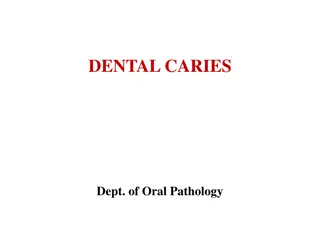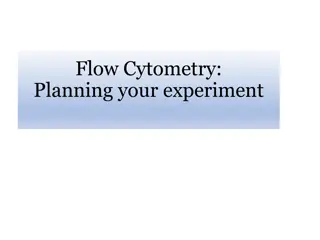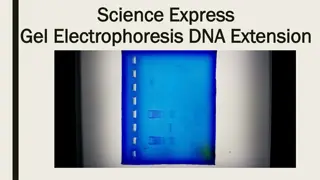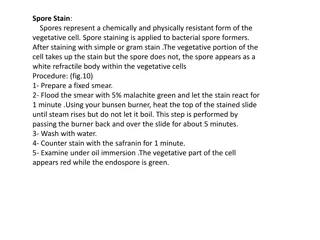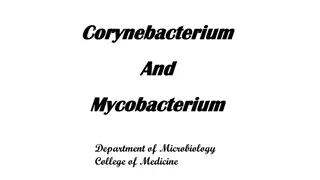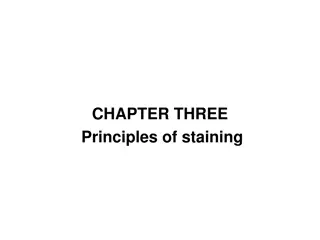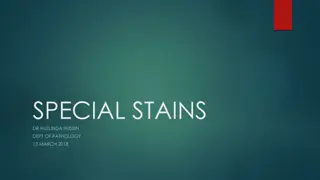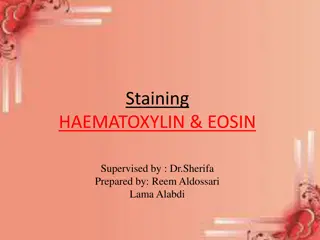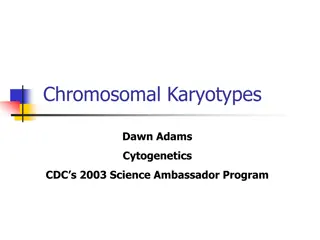Understanding the Principles of Staining in Histopathology
Staining is a crucial technique in histopathology that involves adding specific dyes to biological substrates to visualize and differentiate cell and tissue components. This chapter covers the principles of staining, types of stains used, factors influencing staining affinity, and common stains employed in histopathologic techniques. By studying this chapter, students will gain insights into staining processes, dye-tissue interactions, and the classification of stains based on mordants. The content delves into why tissue components stain, types of stains like negative, supravital, special, and differential stains, and the significance of staining in enhancing contrast for better visualization of cells and extrinsic materials.
Download Presentation

Please find below an Image/Link to download the presentation.
The content on the website is provided AS IS for your information and personal use only. It may not be sold, licensed, or shared on other websites without obtaining consent from the author. Download presentation by click this link. If you encounter any issues during the download, it is possible that the publisher has removed the file from their server.
E N D
Presentation Transcript
Chapter 4 Principle of staining 9/21/2024 1
Content Introduction Types of stain Affinity of staining Factors that determine selectivity of stain Types of commonly used stains in histopathologic techniques 9/21/2024 2
Learning objectives Upon completion of this chapter, the student will be able to: Define staining. Discuss factors that contribute to dye-tissue affinity. Explain factors affecting selectivity of stain. Explain the classification of hematoxylin on the basis of mordant used. 9/21/2024 3
5.1. Introduction Staining: is a biochemical technique of adding a classic specific dye to a substrate: DNA Proteins Lipids and Carbohydrates To qualify or quantify the presence of a specific compound. 9/21/2024 4
Stainingalways involves the visual labeling of some biological entity by attaching, or depositing in its vicinity, a marker of characteristic color or form. Stain is the marker, or the reagent used to generate the marker. 9/21/2024 5
1. Why do any tissue components stain? 2. Why do stained components remain stained? 3. Why are all components not stained? Sections stained with either acid or basic dyes are usually mounted in non-aqueous media to prevent extraction of dye. 9/21/2024 6
5.2. Types of stain 1. Negative stain : is the type of stain that does not color the tissue or cells but surrounds the tissue. uncolored tissue can be seen against a background color. 2. Supravitalstaining is the stain taken by living cells. 3. Special stain is the stain that identifies various specialized structures. e.g. capsule, collagen, glycogen,etc. 4. Differential stain the stain uses two or more dyes that react differently. 9/21/2024 7
Principle of staining: Enhance natural contrast and to make more evident various cell and tissue components and extrinsic material. Most of the dyes behave like acidic or basic compounds and have a tendency to form electrostatic (salt) linkages with ionizable radicals of the tissues. Tissue components that stain more readily with basic dyes are termed basophilic & those with an affinity for acid dyes are termed acidophilic. 9/21/2024 8
Staining.. The unstained slide must go through the reverse process that it went through from paraffin section dewaxing to water(rehydration) . C:\Users\user\Downloads\Video\Histopathology - tissue processing.MP4 The stained slide is taken through dehydration, clearing agents to a point at which a permanent resinous substance beneath the glass cover slip (Mounting) C:\Users\user\Downloads\Video\Histological staining- hematoxylin & eosin - YouTube.MP4 9/21/2024 9
5.3. Affinity of staining Affinity describes the tendency of a stain to transfer from solution onto a section. Affinity is not a one-way procedure but a two-way procedure as it depends on the tissue as well as on the dye. Factors affecting staining of tissues: Solvent-solvent interaction (Hydrophobic bonding) Reagent-reagent interaction Reagent-tissue interaction (Vander -Waal forces) Columbic attraction Hydrogen bonding Covalent bonding. 9/21/2024 10
5.3.1. Solvent-solvent interaction There is a tendency of hydrophobic grouping or chemicals or substances to come together even though initially dispersed in aqueous (water) solution. The water molecules are transiently held together in clusters by hydrogen bonding. These clusters are stabilized by hydrophobic group Any process that involves breakup of the clusters in to disorganized water molecules will tend to occur spontaneously. Phenylalanine and tryptophan side chains or biphenyl naphthol are hydrophobic grouping. 9/21/2024 11
5.3.2. Reagent-reagent interaction Dyeinteracts with each other and form aggregates. Dye aggregation increases with concentration. Cations or basic dyes build up in tissues where there is high negative charge such as; - polysaccharides in mast cell granules and - cartilage matrix. 9/21/2024 12
Reagent-reagent Metachromatic staining : This is due to dye aggregation having spectral properties unlike those of monomeric dyes. Metachromasia takes place when certain negatively charged groups on the tissue react with cationic dyes. On polymerization the original color of the dye changes to another color (eg mast cell stain pink with toluidine blue). Silver impregnation technique: stain-stain Gomer s type enzyme histochemistry: interaction 9/21/2024 13
5.3.3. Dye-tissue interaction or Vander- Walls reaction Van-deer-Walls force: acts between dye and tissues. is of short range. Van-deer-Walls force is strong where close reagent contact is possible. The attraction of intermolecular forces between molecules 9/21/2024 14
Van-deer-Walls force. Substrates and chemicals that favor Van-deer-walls bonding include: Tyrosine and tryptophan residues of proteins; Heterocyclic bases of nucleoproteins; Halogenated dyes such as, - rose Bengal, - phloxine, - enzyme substrate, - naphthyl indoxyl system. 9/21/2024 15
5.3.4 Columbic attraction Istermed as salt link or electrostatic bond. The electrostatic bonds arise from electrostatic attraction of unlike ions is the most widely acknowledged reagent-tissue interaction. Example: The colored cation of basic dyes and tissue structures rich in anion such as - phosphated DNA and RNA - carboxylated or - sulphated mucosubstances. 9/21/2024 16
Columbic attraction.. In case of columbic attraction, the amount of dye able to enter a given tissue will depend on: charge of dye, magnitude of charges, amount of non-electrolyte present in dye bath ability of tissue to shrink or swell. 9/21/2024 17
5.3.5. Hydrogen bonding Hydrogen bonding(H-bonding) is a localized bond when a hydrogen atom lies b/n two electronegative atoms such as ,H and N . It will rarely be an important source of reagent- tissue affinity when aqueous solvents are used. If dye is taken by other process, H- bonding may subsequently contribute to affinity. 9/21/2024 18
5.4. Factors that determine selectivity of stain Dye or stains are not taken by every part of tissue, and this is called selectivity of stain. Factors that determine selectivity of stain include: Number and affinity of binding sites Rates of reagent uptake Rate of reaction Rate of reagent loss. 9/21/2024 19
a) Number and affinity of binding sites The staining affinity of dye depends on: the number of binding sites of the dye to tissue. Reagent-tissue affinities and the number of binding site vary. Example Non-ionic Sudan dye will have affinity for fat droplets, but none for the surrounding hydrated proteins. Therefore, Sudan stains intensely fat tissues and not proteins or carbohydrates. 9/21/2024 20
b)Rate of reagent uptake by the tissue Selectivity of the stain by the tissue depends on the rate of reagent uptake by the tissue. Therefore, selectivity can be controlled by modifying the time of staining. Example: short period of staining : Mucin-staining method using Alcian blue or colloidal iron. prolonged period of staining: Nucleic acid and RNA-rich cytoplasm are also stained using Alcian blue or colloidal iron. 9/21/2024 21
Rate of reagent uptake There are methods where three or more dyes diffuse at varying rates, as a result different structures can be stained by different dyes. Example Collagen fibers stain rapidly while the muscle fibers stain at intermediate rate 9/21/2024 22
c) Rate of reaction Selectivity of the stain also depends on the rate of reaction. This is because, reactive stain yield colored derivatives, & amount of color depend on the selective rates of reaction. Example: The periodic acid oxidation step of the periodic acid- Schiff procedure, if sufficiently prolonged, oxidize various chemical structures present in tissue. 9/21/2024 23
Rate of reaction contd Enzyme histochemistry provides many other examples of reaction rates that affect selectivity. Example At low pH, the hydrolysis of an organic phosphate applied to a tissue section in a suitable incubation media will be rapid in those parts of the tissue containing acid phosphates. However, in structures containing alkaline phosphatase , the hydrolysis rate will be very slow. 9/21/2024 24
d) Rate of reagent loss Some tissues or structures are stained and decolorized readily while other tissues or structures are not decolorized readily. Differentiation is when a decolorized tissue takes up the counter stain. staining of muscle striation with iron Example; Haematoxyline and myelin sheath with Luxol Fast Blue. In regressive staining all structures are first stained quite non-selectively some times with the assistance of penetration aid such as heat or phenol. 9/21/2024 25
Rate of reagent loss. The staining conditions chosen to maximize selective affinity: Basic dyesmust be appliedfrom neutralor acidic solution. The concentration of inorganic salt present in a dye bath ,called critical electrolyte concentration. rate of reagent uptake, or subsequent reaction or loss of reagent or product. 9/21/2024 26
5.5. Types of commonly used stains in histopathologic techniques 1) Haematoxylin (H) is the most popular & widely used histologic stain. extracted from heartwood of the tree called Haematoxylin campechium with hot water. can demonstrate clearly enormous number of different tissue structures. 9/21/2024 27
Natural oxidation of Haematoxyline 1. Natural oxidation(ripening) : is exposing haematoxyline to light & air and converting it to hematin. is a slow process, it may takes 3-4 months. the hematin solution retains its staining ability for a long time. Examples: -Ehrlichs haematoxylin -Delafield s haematoxylin 9/21/2024 28
Haematoxyline.. Haematoxylin also stains tissues that are processed by various methods. In the routine H & E stain, nuclei stain blue-black with good intranuclear details. While Eosin stains cytoplasm and connective tissue in varying intensity of pink, orange & red. Haematoxylin by itself is not stain but haematin, an oxidant product of Haematoxylin is a stain & a natural dye. 9/21/2024 29
Production of haematin from Haematoxylin Haematoxylin is extracted from heartwood or logwood. It is precipitated by using urea. Haematin is produced from Haematoxylin by two ways. 1. Natural oxidation or ripening of Haematoxylin. 2. Chemical oxidation of Haematoxyline; sodium iodate & Mercuric oxide. . 9/21/2024 30
2. Chemical oxidation The use of chemical oxidizing agents converts the hematoxylin to hematein almost instantaneously, are ready for use immediately after preparation. They have a shorter useful life than the naturally oxidized hematoxylins, probably because the continuing oxidation process in air and light eventually destroys much of the hematein, converting it to a colorless compound. Hematein is anionic, having a poor affinity for tissue, and is inadequate as a nuclear stain without the presence of a mordant. 9/21/2024 31
Chemical oxidation The most useful mordants are salts of aluminum, iron, and tungsten. Advantages: Oxidize haematoxylin almost instantaneously; Ready to be used after immediate preparation. Disadvantage: have shorter useful life when compared to naturally ripened haematoxylin. 9/21/2024 32
Classification of haematoxyline based on mordant used Classification of haematoxyline based on mordant: Alum haematoxylin; Iron haematoxylin; Tungsten haematoxylin; Molybdenum haematoxylin; Lead haematoxylin; Haematoxylin with out mordant. 9/21/2024 33
2)Eosin Eosin is a xanthene dye is the most suitable stain when combined with Haematoxylin. used to distinguish & differentiate the cytoplasm of d/t types of cells. Therefore, different types of cells & connective tissue fibers can be distinguished 9/21/2024 34
Eosin Types of eosin Eosin Y (eosin yellow); Ethyl eosin; Eosin B (eosin bluish). Eosin Y Most widely used eosin; It is a water-soluble stain and also satisfactorily soluble in alcohol. 9/21/2024 35
Eosin Eosin solution: 0.5 to 1 % solution is prepared in water. A crystal of thymol is added to prevent fungal growth and the addition of little acetic acid sharpens the staining. 9/21/2024 36
Eosin Use of eosin stains: Eosin stains can be used as differential stain. Differentiation of eosin staining occurs with tap water. Further differentiation occurs during dehydration through alcohols. The intensity of eosin staining and degree of differentiation depend on the examining pathologist. 9/21/2024 37
Eosin Adequate differentiation may be difficult if tissue has been fixed in mercuric oxide. Over differentiation of eosin may be continued until only RBC & granules of eosinophils are stained. This method helps in location & identification of eosinophils. 9/21/2024 38
Eosin Ethyl eosin and Eosin B Ethyl eosin and Eosin B are rarely used, for example, in Harri s stain for Negri bodies. Eosin substitutes Certain red dyes are alternatively used as eosin. They are phloxine, Biebrich scarlet etc. But these chemicals give a more intense red color to tissues and rarely give subtle differentiation & hence, they are less valuable. 9/21/2024 39
Hematoxylin and eosin stain for paraffin sections Method 1. Dewax sections, rehydrate through descending grades of alcohol to water. 2. Remove fixation pigments if necessary. 3. Stain in an alumhematoxylin of choice for a suitable time. 4. Wash well in running tap water until sections blue for 5 minutes or less 5. Differentiate in 1% acid alcohol (1% HCl in 70% alcohol) for 5 10 seconds. 9/21/2024 40
Hematoxylin and eosin stain for 6. Wash well in tap water until sections are again blue (10 15 minutes), or 7. Blue by dipping in an alkaline solution (e.g. ammonia water), followed by a 5-minute tap water wash. 8. Stain in 1% eosin Y for 10 minutes. 9. Wash in running tap water for 1 5 minutes. 10. Dehydrate through alcohols, clear, and mount 9/21/2024 41
5.6. Quick haematoloxylin and eosin stain for urgent frozen section 1. Tissue is frozen onto a chuck using aerosol spray. 2. Cut sections with cryostat of thickness from 3-6 microns. 3. Dip in neutral 10% solutions at room temperature for 20 seconds to fix. 4. Rinse in tap water. 5. Dip in double strength Carazi s haematoxylin to stain. 9/21/2024 42
Quick haematoloxylin and eosin. 6. Dip and rinse in tap water for 10 to 20 seconds. 7. Dip in 1% aqueous eosin for 10 seconds. 8. Dip in tap and rinse. 9. Dehydrate as usual in 50% ,70%, 90%, and 100% alcohol. 10. Clear with xylene and Mount in DPX 9/21/2024 43



